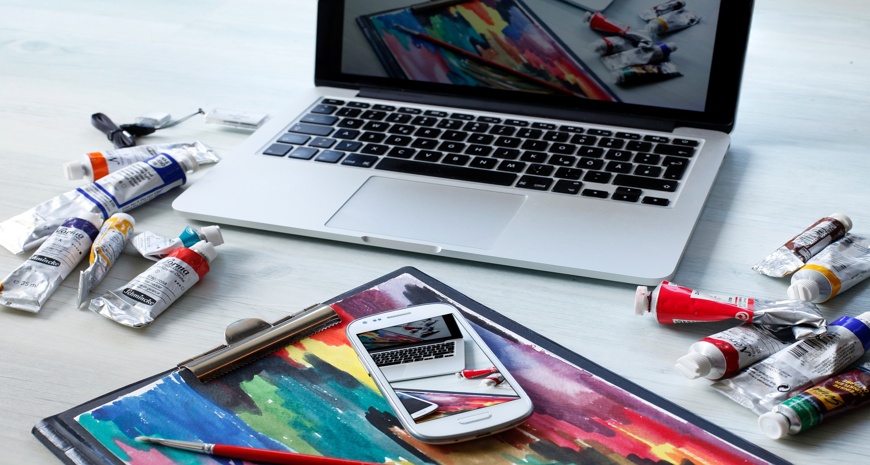How will classical art evolve as it melds with digital art? Will classic art become a thing of the past as more and more artists are mixing traditional techniques with new digital technology? Some of the art world’s most eminent names might argue yes.
A controversy that’s no longer relevant
Classic and digital art become one
Even though many still consider digital art to be cheating, deceptive and fake, a growing number of artists are taking the opposite approach. The latter are even defending a new hybrid style of art in which classical art is enriched by digital art’s novel techniques. These artists believe that their work appears just as authentic as traditional works of art.
Digital art’s potential
Classical and digital art no longer form two distinct fields within the world of art. Some of the most renowned contemporary artists are proving this to be true, as we will see in the second part of this article.
Should we be afraid that technology will supplant traditional forms of art, threatening age-old techniques that have been used throughout art history? One camp of artists and critics believe this to be true while another is welcoming the new frontier of digital art and artificial intelligence.
Classical art's cult following
Digital art may be on the rise – it's increasingly present in our daily lives (media, marketing, etc.) - but classical art is not on the verge of extinction. On the contrary, it continues to thrive. Rest assured, galleries, museums and auction houses are not going to disappear! Physical art will always have the power to attract the human gaze.
The fundamental principles of creating art - color theory, composition, aesthetic expression, etc. - are unshakable pillars. Techniques that have been used for centuries will remain in our collective archive. Technology and art have always inspired each other and contemporary artists are reaching to new computer technologies to embellish their creative processes. Some artists are becoming incredibly famous thanks to these new media!
5 famous artists who are blending classical and digital art
David Hockney
Digital art is rapidly expanding, creating countless new arenas and techniques for artists to explore and experiment with. The renowned artists David Hockney has even dabbled in this new world of art. His latest solo exhibition that took place at the Musée de l'Orangerie in Paris at the end of 2021 was a great success, especially the large painted frieze depicting his house and garden. The frieze was created using his iPad! This massive work of art spans almost 300 feet and was created using a software program that was specially designed for him! The piece is entitled A Year in Normandy (2020) and depicts the changing seasons in Normandy, where this famous pop artist has been living since 2019.
Marina Abramovic
In 2019, photographer and video artist Marina Abramovic gave a highly acclaimed performance in virtual reality called The Life (2019). The audience was present in an empty room, equipped with a VR headset. Abramovic’s 19-minute performance was the first large-scale public exhibition of this genre and underscored a new and intriguing question in performance art – Can an artist’s presence be conveyed even though they are not physically present?
Jeff Koons
Jeff Koons has been bridging the gap between classical and digital art for several years. This American neo-pop artist is known for employing engineers and 3D modelers to help bring his ideas to fruition. In 2017, he also collaborated with Snapchat to bring art created with augmented reality into public places. Jeff Koons was also one of the first artists to release NFT versions of some of his 3D sculptures.
Damien Hirst
The British artist Damien Hirst is another adept crypto artist who is known for launching an NFT project called The Currency. This is Hirst’s largest and most ambitious work to date. He created 10,000 physical paintings and anyone who acquired an NFT had a year to decide whether they wanted to keep the NFT or exchange it for a physical work of art. These paintings depicted circles of colors that were created by computers - the artist never touched a single canvas.
Jérôme Oudot or Trëz
The French artist Jérôme Oudot, AKA Trëz, is not the most famous artist. However, his work is very interesting in that it combines classical and digital art. His digital work is created by scanning physical drawings, which are then enhanced using computers. These pieces are then printed in various formats and media in limited editions. He is an emerging artist that you should keep your eye on over the next few years.
Voilà, we hope that you enjoyed this article about artists who are bridging the gap between classical and digital art with new and exciting techniques. We hope to see you soon for more news from the art world. In the meantime, feel free to explore our carefully curated virtual galleries of paintings, drawings, photographs, sculptures and limited edition prints by contemporary artists.
 English
English Français
Français


You must be logged in to post a comment.
Click here to log in